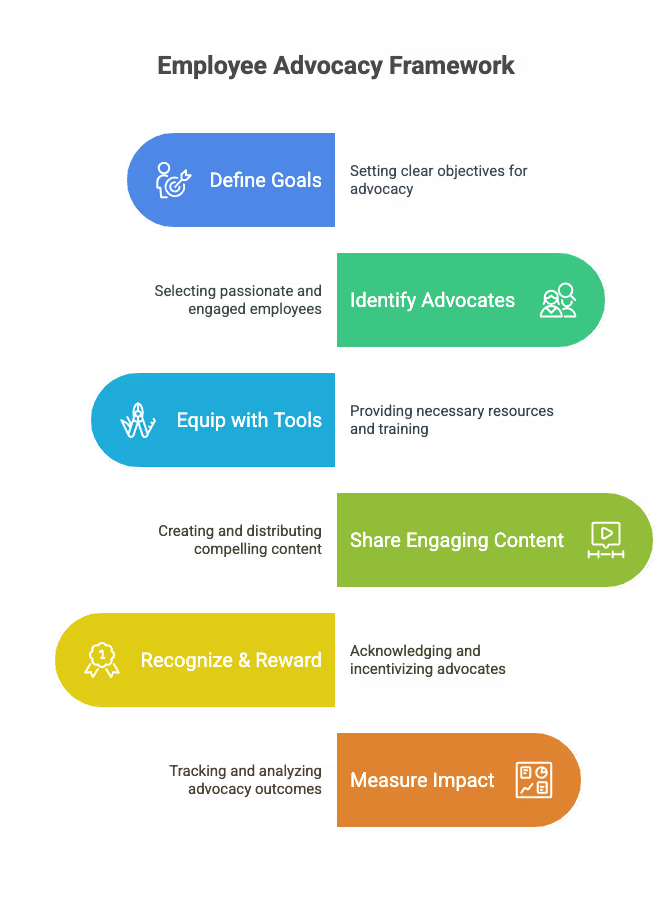Employee advocacy is no longer just a feel-good concept tucked away in internal newsletters. It’s a strategic power move that blends the worlds of HR, marketing, and real-time reputation building. Think of it this way: your people are already talking about where they work, sharing moments on LinkedIn, celebrating wins on Instagram, or simply recommending your company to a friend over coffee. That’s advocacy , raw, real, and potent.
For HR professionals, this represents a golden opportunity. When employees share genuine stories about their workplace, they create ripple effects that can influence hiring decisions, elevate your employer brand, and boost team morale. It’s not about handing employees a script, it’s about empowering them with the confidence, tools, and culture that make them want to shout your brand from the rooftops.
In this blog, we’re diving into what employee advocacy actually means, why it should be top-of-mind for HR leaders, how to build it intentionally, and what the future holds for this powerful people-led strategy.
What is Employee Advocacy?
Let’s break it down: employee advocacy is when your people voluntarily promote your company. Its culture, values, wins, and mission—through their own voices. This could be a LinkedIn post about a team offsite, a photo on Instagram highlighting your CSR initiative, or even a casual conversation with a potential hire.
What makes employee advocacy so impactful is the authenticity. While employer branding is often curated by the marketing team, employee advocacy feels real because it is real. It reflects how employees truly feel and what they’re proud of. It goes beyond “we love our job!” and taps into stories that connect about leadership, growth, values, and purpose.
And unlike internal engagement, which stays within company walls, advocacy has a public-facing power. It opens doors to better candidate pipelines, richer brand narratives, and increased trust in what you stand for.
The Role of Employees as Brand Advocates
Your employees aren’t just part of your workforce—they’re your most relatable storytellers and most trusted brand champions. Whether they’re sharing a behind-the-scenes look at life in your company or reacting to big company wins, they hold the power to make your brand feel human and credible.
Why employees matter as brand advocates:
- They influence through trust, not ads
People are more likely to trust a peer than a polished press release. When employees share updates, success stories, or workplace wins, it cuts through the noise. According to LinkedIn, employee-shared content generates 8x more engagement than corporate channels.
- They extend your reach without extra budget
Employees naturally connect with friends, former colleagues, and industry peers. Every share or post expands your brand’s reach across diverse and often untapped networks.
- They humanize your brand in the real world
Whether volunteering in the community, attending events, or simply interacting online, employees bring personality to your brand—making it more approachable, relatable, and trustworthy.
Real-World Wins
- Salesforce leverages employee voices to share innovations and events, amplifying trust and engagement.
- Adobe’s #AdobeLife campaign features employee-driven content that paints a picture of the brand from within.
- Zappos allows employees to share freely about their quirky, inclusive culture—strengthening its reputation for authenticity.
Keywords: employees as brand advocates, employee brand ambassadors
Why HR Professionals Should Prioritize Employee Advocacy
HR leaders are tasked with doing more than just hiring and retaining talent—they’re culture shapers and brand stewards. And that’s exactly why employee advocacy belongs at the heart of every HR strategy.
Here's what’s in it for HR:
Recruitment marketing gets a major upgrade
Think of every employee post as a micro-recruitment ad. Candidates trust employees more than they trust recruiters or brand pages. When job seekers see real people celebrating workplace culture, they’re far more likely to consider applying.
Employee engagement and pride get a boost
Advocacy creates a sense of ownership. When employees feel trusted enough to represent the brand, it nurtures pride and belonging. This, in turn, leads to stronger retention and overall morale.
It strengthens alignment with company values
When employees actively promote their workplace, they’re not just endorsing a logo—they’re living out your mission and values. This helps reinforce a unified sense of purpose across teams.
It brings visibility to DE&I voices
Advocacy programs are also a platform for elevating underrepresented voices. It allows your company culture to shine through diverse stories—whether about career growth, inclusion, or leadership.
5. How to Build a Successful Employee Advocacy Program
Creating an advocacy program doesn’t mean forcing employees to promote you. It means nurturing an environment where they want to share. Here’s how HR can build a thoughtful and engaging program from the ground up:

5.1 Define Purpose and Metrics
Before launching, get clear on what success looks like. Are you trying to improve employer brand awareness? Get more referral hires? Or simply boost internal pride?
Set KPIs like:
- Number of employee shares or posts
- Referral applications and hires
- Engagement on employee-generated content
- Advocacy participation rates
Align these goals with your wider HR and business objectives.
Spot and Support Your Natural Advocates
Not everyone wants to be a social media star and that’s okay. Look for employees who already show excitement about your company: they might volunteer, share wins in Slack, or show up in culture-building efforts.
Ways to identify and support them:
- Run surveys to find advocacy interest
- Encourage managers to nominate team members
- Recognize those who already share positively on social media
Give them tools, not scripts, and recognize their value early on.
Provide Training and Tools
Even the most enthusiastic employee may hesitate to post without guidance. Offering light-touch training can ease those nerves.
What helps:
- Social media do's and don’ts
- Sample messages and content themes
- Visual assets, branded templates, or hashtags
- Tips for telling personal stories that align with company values
When people feel supported, they’re more likely to participate.
Create Share-Worthy Content
People share what they’re proud of—or what makes them smile. So don’t just push company news—create emotional, relatable moments.
Content that performs:
- Day-in-the-life stories from different teams
- Culture snapshots (team events, remote work setups, behind-the-scenes)
- Employee spotlights or career journeys
- Company impact stories: volunteering, innovation, diversity efforts
Make it visual, bite-sized, and easy to personalize.
.avif)
Recognize and Celebrate Advocates
A little recognition goes a long way. Advocacy isn’t just about reach—it’s about relationship.
How to keep momentum:
- Shout-outs in company town halls or newsletters
- Small rewards (badges, gift cards, social spotlights)
- Leaderboards or friendly competitions for internal engagement
Recognition reinforces that their voice matters and builds a culture where others want to join in.
Overcoming Common Challenges in Employee Advocacy
Even with the best intentions, employee advocacy can hit a few bumps. From hesitation about posting to concerns over brand consistency, here’s how HR can address these early on.
Challenge: “What if I say the wrong thing?”
Many employees feel nervous about mixing personal identity with brand messaging. The key is to keep it real, not rehearsed.
Solution:
Provide loose guidelines—not scripts. Encourage authenticity, not perfection. Let employees know it’s okay to be informal or speak from their own perspective. Offer examples of past posts that did well.
Challenge: Compliance and Consistency
Especially in regulated industries, there’s a risk of sharing sensitive or off-brand content.
Solution:
Offer short legal do’s and don’ts. Share a pre-approved content library. Appoint a content lead to help review posts when needed.
Challenge: “This program isn’t for people like me”
If your program skews toward one department or demographic, others may feel excluded.
Solution:
Make participation inclusive and flexible. Feature stories from all corners of the company—remote workers, junior staff, and diverse communities. Offer content formats beyond just text—photos, videos, and even voice messages.
Measuring the Impact of Employee Advocacy on HR Goals
You can’t manage what you don’t measure. Advocacy might feel intangible at first, but with the right tools, you can draw a clear line from employee stories to tangible HR outcomes.
What to Track:
- Engagement metrics: Likes, shares, comments on employee-generated posts
- Recruitment wins: Increase in referral candidates, faster time-to-hire
- Internal feedback: Surveys on pride, advocacy readiness, or NPS
- Content insights: Topics or formats that consistently perform well
Tools That Help:
- LinkedIn Elevate – For sharing and tracking professional posts
- EveryoneSocial / GaggleAMP – Great for curating shareable content
- Internal HR dashboards – Use them to compare engagement or retention metrics before and after launching advocacy programs
8. Future Trends in Employee Advocacy for HR Professionals
Employee advocacy is evolving fast—and it’s not just about posting anymore. It’s about building relationships, trust, and transparency in a world where authenticity wins.
What’s Next?
- Influencer + Employee Blending: Companies are mixing external influencers with internal voices to build credibility and scale reach.
- AI and Social Listening: Tools now help customize employee content and analyze public sentiment in real-time—making advocacy smarter.
- Mental Health and Real Talk: Advocacy is becoming more human. Expect stories not just about wins, but about struggles, personal growth, and workplace well-being.
Employee voices will continue to rise in influence. HR teams that lean in now will lead tomorrow.
9. Conclusion
Employee advocacy is more than a tactic- It’s a cultural advantage. When HR enables people to share their stories, it builds a stronger, more relatable brand and deepens internal engagement at the same time.
So don’t overthink it. Start small. Identify a few champions. Offer a toolkit. Celebrate their voices. And watch the ripple effect grow—one authentic post at a time.
Your employees are already talking about you. The question is - are you empowering them to lead the conversation?














































.avif)